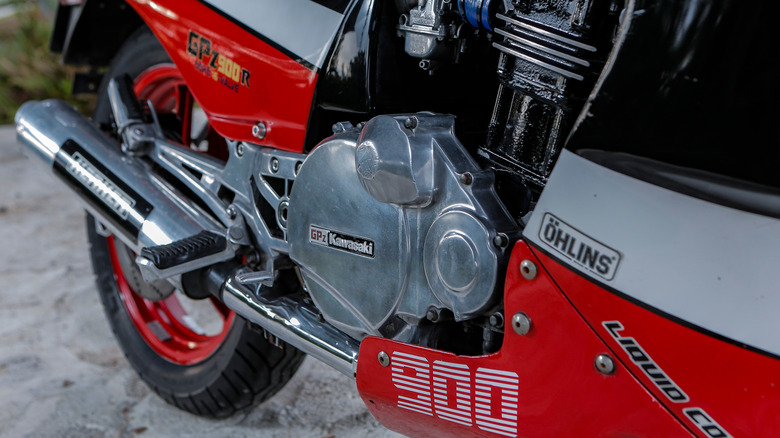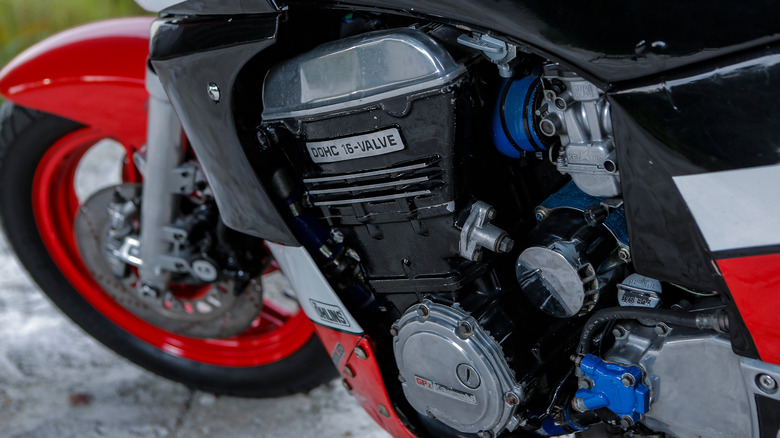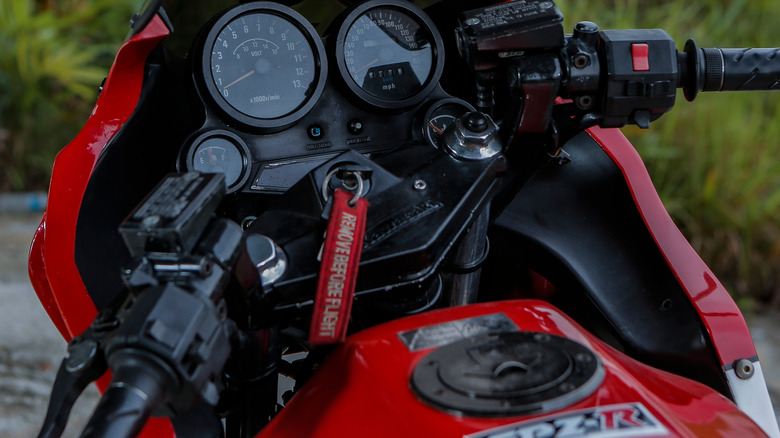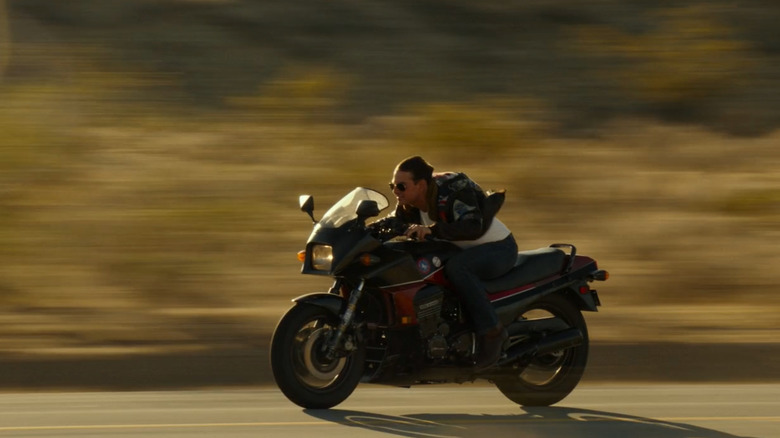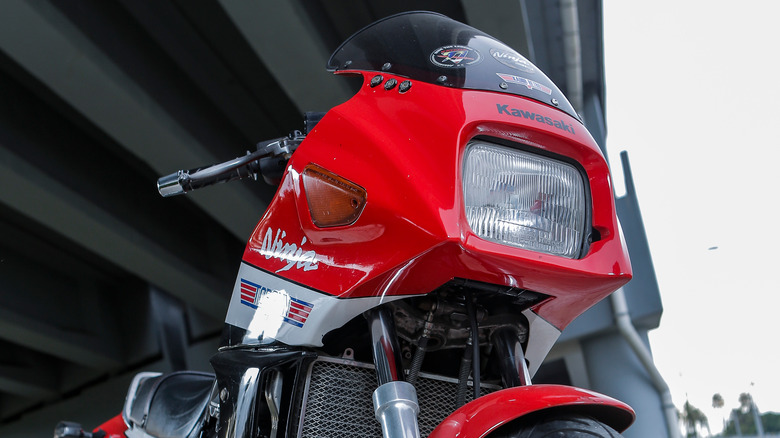4 Facts About The Kawasaki GPz900R Motorcycle Only Hardcore Ninja Fans Probably Know
Kawasaki began producing motorcycles in the early 1960s and soon expanded across the globe, introducing the 500 cc H1 Mach III at the end of the decade. The four-cylinder Z1 followed in 1972, and fuel injection appeared on the GPz1100 a decade later. In 1984, Kawasaki produced the GPz900R, otherwise known as the ZX 900A or the Ninja 900. This bike was the first in the long and famous series of sport bikes that includes the street-friendly Ninja 400 and 650 models, as well as the racetrack-only Ninja H2R.
None of those beasts would exist if not for the original Ninja, which kick-started a 40-year run for the super bike that is still going strong. The Ninja series is now famous across the world and well-known even to folks who have never sat on a motorcycle. Here are a few tidbits of information even loyal Kawasaki riders may not know about the granddaddy of the Ninja line.
The Ninja 900's engine marked an industry first
The engine that powered the GPz900R had some pioneering technology: it was the first liquid-cooled 16-valve motorcycle engine, and it helped the GPz900R crack the 150 mile per hour barrier. The 908 cubic centimeter engine produced 115 horsepower and 61 lb-ft of torque. In comparison, the 1984 Volkswagen Rabbit had a 1.7 liter engine that made 74 horsepower and 90 pound-feet of torque and maxed out at 99 miles per hour.
During the GPz900R's development process, Kawasaki's engineers realized a diamond-frame construction could be achieved by using the engine as part of the bike's structure. Extensive road testing showed that the engine could be used as a stressed frame member, and production moved forward with a steel main frame and aluminum seat rail. The production version of the Gpz900R had a dry weight of just over 500 pounds, allowing it to cover a quarter mile from a stop in 10.9 seconds.
The GPz900R was relatively low tech
Other than the innovative frame configuration and groundbreaking engine design, the GPz900R was fairly low tech. Although many 1980s vehicles featured digital gauges and LCD screens that overloaded the driver with unnecessary information, the Ninja 900's gauge cluster was a simple layout of four round analog dials. A large speedometer and combination volt meter and tachometer sat side-by-side just below where the windscreen met the fairing, and smaller fuel and temperature gauges were placed between the handlebars. All four gauges were given white markings on a black background, making them easy to read at speed.
There was no fuel injection on the GPz900R, just an array of four 34 millimeter Keihin carburetors; one for each engine cylinder. The transmission was an old-school six-speed manual, and the most advanced major feature on the bike was the anti-dive hydraulic front suspension. The GPz900R was by no means primitive, with electronic ignition as opposed to points and a push-button starter instead of a kick lever.
Maverick's GPz900R in 'Top Gun' was almost a Honda
Many recognize the GPz900R as the terrestrial vehicle of choice for Pete "Maverick" Mitchell (Tom Cruise) in the two "Top Gun" films, but that famous Ninja was almost a Honda. When the first movie was in the works prior to its 1986 release, producers went to Honda seeking permission to use one of their bikes as Maverick's ride. Honda seemed willing to provide the product placement until producers revealed that Cruise would be riding without a helmet. California had no mandatory helmet law at the time, but Honda wanted to keep an emphasis on safety, and the filmmakers moved on to Kawasaki.
In the 2022 sequel, "Top Gun: Maverick," Mitchell's primary ride is once again a Ninja, but it's a newer H2 Carbon. He does take his old Ninja for a ride in the film after pulling a tarp from it in his dusty, crowded garage. The GPz900R used in the sequel was a restored bike owned by collector Norm Bigelow, who displayed it at that year's Japanese Classic Car Show. "I happened to have a good running example of an unrestored correct year model and agreed to let the studio use it for the movie," Bigelow said. "I researched the paint scheme from the original bike and had it copied to be a perfect replica as possible."
The GPz900R was developed in secret
The Ninja 900's development was a secretive six-year process that likely would not have been possible to keep under wraps in the era of social media leaks and ubiquitous camera phones. The patience displayed by Kawasaki's executives allowed its engineers to wring the most from the engine and develop the rigid, lightweight frame structure. A prototype that was produced in 1980 had a six-cylinder engine that ran so smoothly that the development team felt it seemed too tame to bring to market underneath a performance bike.
When engineers went back to a four-cylinder, 16-valve architecture, they employed a second external balancer to control vibration. The Ninja name was only used in the United States and came from Kawasaki U.S.A. Marketing Director Mike Vaughan, who had used it on the transom of his sailboat 10 years before the GPz900R was ready for market. Vaughn told Hagerty the sailboat's name was an inspiration from his time living in Asia while serving in the Army. "Ultimately, it took a decade and a lot of effort for the name to get from the idea stage through all the corporate channels here and in Japan, but in the end it was perfect," he said.
